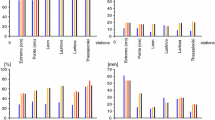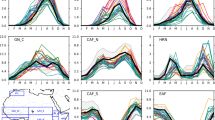Abstract
This study presents future changes in extreme precipitation as projected within the New South Wales and Australian Capital Territory Regional Climate Modelling (NARCliM) project’s regional climate ensemble for south-east Australia. Model performance, independence and projected future changes were considered when designing the ensemble. We applied a quantile mapping bias correction to the climate model outputs based on theoretical distribution functions, and the implications of this for the projected precipitation extremes is investigated. Precipitation extremes are quantified using several indices from the Expert Team on Climate Change Detection and Indices set of indices. The bias correction was successful in removing most of the magnitude bias in extreme precipitation but does not correct biases in the length of maximum wet and dry spells. The bias correction also had a relatively small effect on the projected future changes. Across a range of metrics, robust increases in the magnitude of precipitation extreme indices are found. While these increases are often in-line with a continuation of the trends present over the last century, they are not found to be statistically significant within the ensemble as a whole. The length of the maximum consecutive wet spell is projected to remain at present-day levels, while the length of the maximum dry spell is projected to increase into the future. The combination of longer dry spells and increases in extreme precipitation magnitude indicate an important change in the character of the precipitation time series. This could have considerable hydrological implications since changes in the sequencing of events can be just as important as changes in event magnitude for hydrological impacts.









Similar content being viewed by others
References
Andrys J, Lyons TJ, Kala J (2015) Multidecadal evaluation of WRF downscaling capabilities over Western Australia in simulating rainfall and temperature extremes. J Appl Meteor Climatol 54:370–394. doi:10.1175/JAMC-D-14-0212.1
Andrys J, Lyons TJ, Kala J (2016) Evaluation of a WRF ensemble using GCM boundary conditions to quantify mean and extreme climate for the southwest of Western Australia (1970–1999). Int J Climatol. doi:10.1002/joc.4641
Argüeso D, Hidalgo-Muñoz JM, Gámiz-Fortis SR, Esteban-Parra MJ, Castro-Díez Y (2012) High-resolution projections of mean and extreme precipitation over Spain using the WRF model (2070–2099 versus 1970–1999. J Geophys Res 117:D12108. doi:10.1029/2011JD017399
Argüeso D, Evans JP, Fita L (2013) Precipitation bias correction of very high resolution regional climate models. Hydrol Earth Syst Sci 17:4379–4388. doi:10.5194/hess-17-4379-2013
Barrera-Escoda A, Gonçalves M, Guerreiro D, Cunillera J, Baldasano JM (2014) Projections of temperature and precipitation extremes in the north western Mediterranean Basin by dynamical downscaling of climate scenarios at high resolution (1971–2050. Clim Chang 122:567–582. doi:10.1007/s10584-013-1027-6
Bhend J, Whetton P (2015) Evaluation of simulated recent climate change in Australia. Aust Meteorol Oceanogr J 65:4–18
Bishop CH, Abramowitz G (2013) Climate model dependence and the replicate Earth paradigm. Clim Dyn 41:885–900. doi:10.1007/s00382-012-1610-y
Chan SC, Kendon EJ, Fowler HJ, Blenkinsop S, Ferro CAT, Stephenson DB (2013) Does increasing the spatial resolution of a regional climate model improve the simulated daily precipitation? Clim Dyn 41:1475–1495. doi:10.1007/s00382-012-1568-9
Chan SC, Kendon EJ, Fowler HJ, Blenkinsop S, Roberts NM, Ferro CAT (2014) The value of High-Resolution Met Office Regional Climate Models in the simulation of multihourly precipitation extremes. J Clim 27:6155–6174. doi:10.1175/JCLI-D-13-00723.1
Chen J, Brissette FP, Chaumont D, Braun M (2013) Performance and uncertainty evaluation of empirical downscaling methods in quantifying the climate change impacts on hydrology over two north American river basins. J Hydrol 479:200–214. doi:10.1016/j.jhydrol.2012.11.062
Colman RA, Moise AF, Hanson LI (2011) Tropical Australian climate and the Australian monsoon as simulated by 23 CMIP3 models. J Geophys Res 116:D10116. doi:10.1029/2010JD015149
Di Luca A, Evans JP, Pepler A, Alexander L, Argüeso D (2015) Resolution sensitivity of cyclone climatology over eastern Australia using six reanalysis products. J Clim 28:9530–9549. doi:10.1175/JCLI-D-14-00645.1
Di Luca A, Argüeso D, Evans JP, de Elía R, Laprise R (2016a) Quantifying the overall added value of dynamical downscaling and the contribution from different spatial scales. J Geophys Res Atmospheres 121:1575–1590. doi:10.1002/2015JD024009
Di Luca A, Evans JP, Pepler A, Alexander LV, and Argueso D (2016b) Australian East Coast Lows in a Regional Climate Model ensemble. J South Hemisphere Earth Syst Sci
Dosio A, Panitz H-J, Schubert-Frisius M, Lüthi D (2014) Dynamical downscaling of CMIP5 global circulation models over CORDEX-Africa with COSMO-CLM: evaluation over the present climate and analysis of the added value. Clim Dyn 44:2637–2661. doi:10.1007/s00382-014-2262-x
Dowdy AJ, Mills GA, Timbal B (2013a) Large-scale diagnostics of extratropical cyclogenesis in eastern Australia. Int J Climatol 33:2318–2327. doi:10.1002/joc.3599
Dowdy AJ, Mills GA, Timbal B, Griffiths M, Wang Y (2013b) Understanding rainfall projections in relation to extratropical cyclones in eastern Australia. Aust. Meteorol. Oceanogr. J. 63:355–364
Dowdy AJ, Grose MR, Timbal B, Moise A, Ekström M, Bhend J, Wilson L (2015) Rainfall in Australia’s eastern seaboard: a review of confidence in projections based on observations and physical processes. Aust. Meteorol. Oceanogr. J. 65:107–126
Evans JP, McCabe MF (2013) Effect of model resolution on a regional climate model simulation over Southeast Australia. Clim Res 56:131–145. doi:10.3354/cr01151
Evans J, Ekström M, Ji F (2012) Evaluating the performance of a WRF physics ensemble over South-East Australia. Clim Dyn 39:1241–1258. doi:10.1007/s00382-011-1244-5
Evans JP, Ji F, Abramowitz G, Ekström M (2013) Optimally choosing small ensemble members to produce robust climate simulations. Environ Res Lett 8:044050. doi:10.1088/1748-9326/8/4/044050
Evans JP, Ji F, Lee C, Smith P, Argüeso D, Fita L (2014) Design of a regional climate modelling projection ensemble experiment—NARCliM. Geosci Model Dev 7:621–629. doi:10.5194/gmd-7-621-2014
Grose M, Timbal B, Wilson L, Bathols J, Kent D (2015a) The subtropical ridge in CMIP5 models, and implications for projections of rainfall in Southeast Australia. Aust. Meteorol. Oceanogr. J. 65:90–106
Grose MR, Bhend J, Argüeso D, Ekström M, Dowdy AJ, Hoffmann P, Evans JP, Timbal B (2015b) Comparison of various climate change projections of eastern Australian rainfall. Aust. Meteorol. Oceanogr. J. 65:72–89
Hope P et al. (2015) Seasonal and regional signature of the projected southern Australian rainfall reduction. Aust. Meteorol. Oceanogr. J. 65:54–71
IPCC (2013) Climate change 2013. In: Stocker TF et al. (eds) The physical science basis. Contribution of working group I to the fifth assessment report of the intergovernmental panel on climate change. Cambridge University Press, Cambridge, United Kingdom and New York, NY, USA, p. 1535
Ji F, Ekström M, Evans JP, Teng J (2014) Evaluating rainfall patterns using physics scheme ensembles from a regional atmospheric model. Theor Appl Climatol 115:297–304. doi:10.1007/s00704-013-0904-2
Ji F, Evans JP, Argueso D, Fita L, Luca AD (2015) Using large-scale diagnostic quantities to investigate change in East Coast lows. Clim Dyn:1–11. doi:10.1007/s00382-015-2481-9
Johnson F, Sharma A (2015) What are the impacts of bias correction on future drought projections? J Hydrol 525:472–485. doi:10.1016/j.jhydrol.2015.04.002
Jones DA, Wang W, Fawcett R (2009) High-quality spatial climate data-sets for Australia. Aust Meteorol Mag 58:233–248
King AD, Alexander LV, Donat MG (2013) The efficacy of using gridded data to examine extreme rainfall characteristics: a case study for Australia. Int J Climatol 33:2376–2387. doi:10.1002/joc.3588
Kopparla P, Fischer EM, Hannay C, Knutti R (2013) Improved simulation of extreme precipitation in a high-resolution atmosphere model. Geophys Res Lett 40:5803–5808. doi:10.1002/2013GL057866
Lee J-W, Hong S-Y (2014) Potential for added value to downscaled climate extremes over Korea by increased resolution of a regional climate model. Theor Appl Climatol 117:667–677. doi:10.1007/s00704-013-1034-6
Moise A et al. (2015) Evaluation of CMIP3 and CMIP5 models over the Australian region to inform confidence in projections. Aust. Meteorol. Oceanogr. J. 65:19–53
Olson R, Evans JP, Di Luca A, and Argueso D (2016) The NARCliM Project: Model Agreement and Significance of Climate Projections. Clim Res. Accepted 17 May 2016
Pepler AS, Di Luca A, Ji F, Alexander LV, Evans JP, Sherwood SC (2014) Impact of identification method on the inferred characteristics and variability of Australian East Coast lows. Mon Weather Rev 143:864–877. doi:10.1175/MWR-D-14-00188.1
Pepler AS, Di Luca A, Ji F, Alexander LV, Evans JP, and Sherwood SC (2016) Projected changes in east Australian midlatitude cyclones during the twenty-first century. Geophys Res Lett 43: 2015GL067267. doi:10.1002/2015GL067267
Perkins SE, Pitman AJ, Holbrook NJ, McAneney J (2007) Ability of global climate models at a regional scale over Australia. Int J Glob Environ Issues 7:275–287
Piani C, Haerter JO, Coppola E (2010) Statistical bias correction for daily precipitation in regional climate models over Europe. Theor Appl Climatol 99:187–192. doi:10.1007/s00704-009-0134-9
Prein AF et al. (2015a) Precipitation in the EURO-CORDEX 0.11^{\circ } and 0.44^{\circ } simulations: high resolution, high benefits? Clim Dyn 46:383–412. doi:10.1007/s00382-015-2589-y
Prein AF et al. (2015b) A review on regional convection-permitting climate modeling: demonstrations, prospects, and challenges. Rev Geophys . doi:10.1002/2014RG0004752014RG000475
Quintana Seguí P, Ribes A, Martin E, Habets F, Boé J (2010) Comparison of three downscaling methods in simulating the impact of climate change on the hydrology of Mediterranean basins. J Hydrol 383:111–124
Rocheta E, Sugiyanto M, Johnson F, Evans J, Sharma A (2014) How well do general circulation models represent low-frequency rainfall variability? Water Resour Res 50:2108–2123. doi:10.1002/2012WR013085
Schär C, et al. (2016) Percentile indices for assessing changes in heavy precipitation events. Clim Change :1–16. doi:10.1007/s10584–016–1669-2
Sillmann J, Kharin VV, Zwiers FW, Zhang X, Bronaugh D (2013) Climate extremes indices in the CMIP5 multimodel ensemble: part 2. Future climate projections. J. Geophys. Res. Atmospheres 118:2473–2493. doi:10.1002/jgrd.50188
Skamarock WC, Klemp JB, Dudhia J, et al. (2008) A description of the advanced research WRF version 3. NCAR, Boulder, CO, USA
Suppiah R, Hennessy K, Whetton PH, McInnes K, Macadam I, Bathols J, Ricketts J, Page CM (2007) Australian climate change projections derived from simulations performed for the IPCC 4th assessment report. Aust Meteorol Mag 56:131–152
Tebaldi C, Arblaster JM, Knutti R (2011) Mapping model agreement on future climate projections. Geophys Res Lett 38:L23701. doi:10.1029/2011GL049863
Teng J, Potter NJ, Chiew FHS, Zhang L, Wang B, Vaze J, Evans JP (2015) How does bias correction of regional climate model precipitation affect modelled runoff? Hydrol Earth Syst Sci 19:711–728. doi:10.5194/hess-19-711-2015
Teutschbein C, Seibert J (2012) Bias correction of regional climate model simulations for hydrological climate-change impact studies: review and evaluation of different methods. J Hydrol 456–457:12–29. doi:10.1016/j.jhydrol.2012.05.052
Toreti A et al. (2013) Projections of global changes in precipitation extremes from Coupled Model Intercomparison Project Phase 5 models. Geophys Res Lett 40:4887–4892. doi:10.1002/grl.50940
Torma C, Giorgi F, and Coppola E (2015) Added value of regional climate modeling over areas characterized by complex terrain—Precipitation over the Alps. J Geophys Res Atmospheres 120: 2014JD022781. doi:10.1002/2014JD022781
Tripathi OP, Dominguez F (2013) Effects of spatial resolution in the simulation of daily and subdaily precipitation in the southwestern US. J. Geophys. Res. Atmospheres 118:7591–7605. doi:10.1002/jgrd.50590
Westra S, Alexander LV, Zwiers FW (2012) Global increasing trends in annual maximum daily precipitation. J Clim 26:3904–3918. doi:10.1175/JCLI-D-12-00502.1
Westra S et al. (2014) Future changes to the intensity and frequency of short-duration extreme rainfall. Rev Geophys 52:522–555. doi:10.1002/2014RG000464
White CJ, McInnes KL, Cechet RP, Corney SP, Grose MR, Holz GK, Katzfey JJ, Bindoff NL (2013) On regional dynamical downscaling for the assessment and projection of temperature and precipitation extremes across Tasmania. Australia Clim Dyn 41:3145–3165. doi:10.1007/s00382-013-1718-8
Acknowledgments
This work was made possible by funding from the NSW Office of Environment and Heritage backed NSW/ACT Regional Climate Modelling Project (NARCliM) and the Australian Research Council as part of the Future Fellowship FT110100576 and Linkage Project LP120200777. The modelling work was undertaken on the NCI high performance computers in Canberra, Australia, supported by the Australian Commonwealth Government.
Author information
Authors and Affiliations
Corresponding author
Electronic supplementary material
ESM 1
(PDF 1062 kb)
Rights and permissions
About this article
Cite this article
Evans, J.P., Argueso, D., Olson, R. et al. Bias-corrected regional climate projections of extreme rainfall in south-east Australia. Theor Appl Climatol 130, 1085–1098 (2017). https://doi.org/10.1007/s00704-016-1949-9
Received:
Accepted:
Published:
Issue Date:
DOI: https://doi.org/10.1007/s00704-016-1949-9




